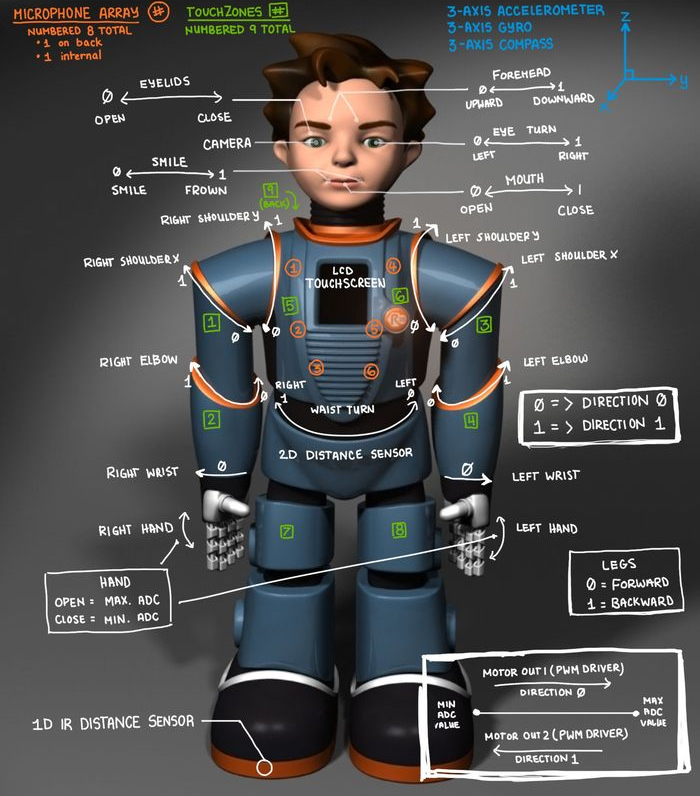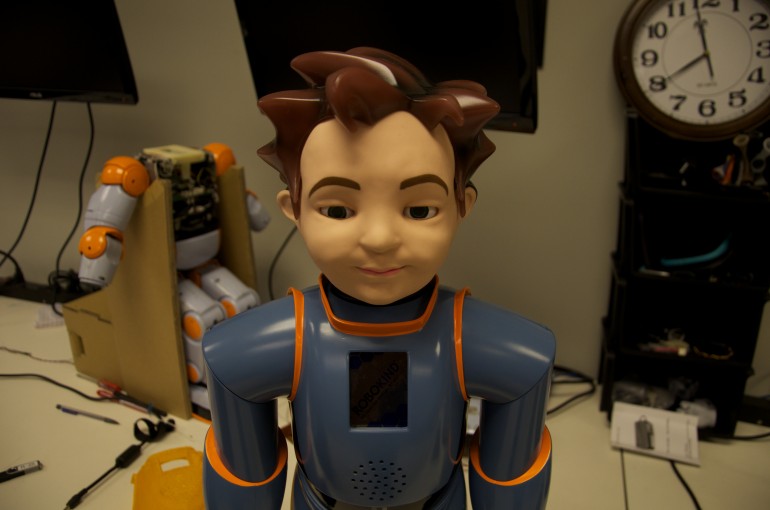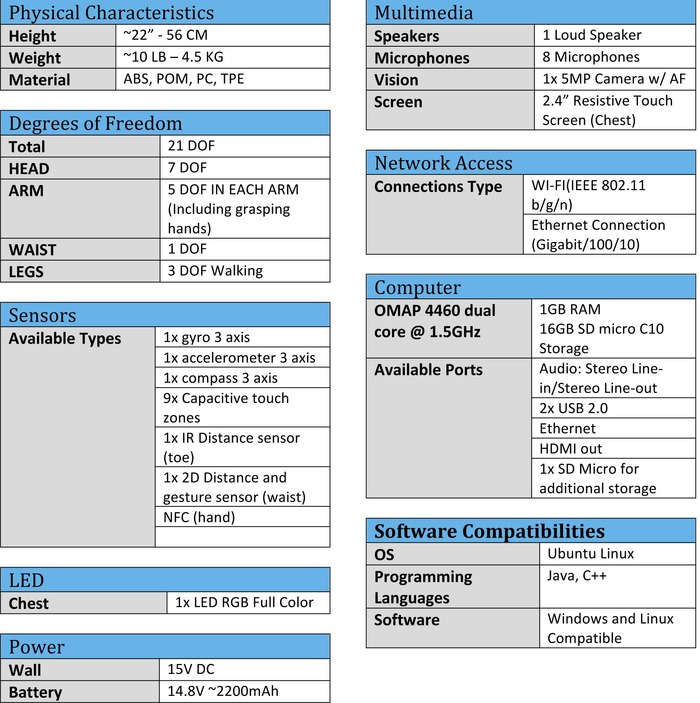On the Kickstarter they raise funds for the robot Robokind Zeno R25, which is able to recognize and imitate emotions.
Currently, the American Kickstarter is collecting funds for a project to create a robot Robokind Zeno R25, which is able to recognize and imitate emotions. The project ends on November 23. The goal of the campaign is an amount of $ 50,000 (ten days before the end of the project, $ 15,000 was raised). We are not campaigning for the respected Habr to support the project (but we are not discouraging doing this), we just want to tell you more about this robot, so that it is clear at what stage of development robotics is today and how much is available for the layman. After all, if the Kickstarter campaign ends successfully, the first deliveries of the Zeno R25 (and it will cost only $ 2,700) will begin in March 2014.

')
RoboKind, formerly known as Hanson Robotics, has been working on creating interactive robots for several years already: Einstein robot, Diego-san robot child, and an early version of Zeno. On the basis of previous developments, an idea emerged to create a robot capable of realistically displaying human emotions, and then combining it with high-level artificial intelligence.
RoboKind already has a fairly solid reputation, but the company has not yet been able to enter the consumer market, because the price of each robot remains quite high. Their previous model, the Zeno R50, costs $ 16,000, and it is unlikely that a simple consumer can afford such a purchase. The Zeno R25 is being developed as an inexpensive version of the R50, and its cost will be $ 2,700.



Although the external Zeno R25 looks like a big toy, inside it is a rather complicated car. The robot is equipped with a dual-core ARM processor with a clock frequency of 1.5 GHz, 1 GB of RAM and 8 GB of internal memory, which can be expanded with a slot for microSD cards. Zeno R25 is powered by open source software that enthusiasts can change to their liking. Zeno R25 supports wireless Wi-Fi and Bluetooth.

Since the robot is interactive, its right eye is equipped with a 5 megapixel autofocus camera. Camera control algorithms allow the Zeno R25 to distinguish colors, movement, faces and read QR codes. In addition, the system CompuCompassion, developed by Robokind, has provided the robot with the ability to identify emotions and respond to them.
For the perception of audio information, the Zeno R25 is equipped with 8 noise-canceling microphones. A resistive touch screen with a resolution of 240 x 320 pixels mounted on the chest of the robot is used for control and adjustment. Also, the Zeno R25 is equipped with infrared sensors for determining the distance, a compass, a gyroscope, an accelerometer and a speaker, and there are nine touch sensitive areas on its body. The photo is presented at the very beginning.
In motion, the Zeno 25 drives 21 engines, which is mounted inside a body with 15 degrees of freedom. The robot can move forward, backward and turn. Even his face has six degrees of freedom, which allows expressing a wide range of emotions during non-verbal communication.
RoboKind sees a number of advantages for the robot, which can detect and show emotions. As an entertainment, the Zeno R25 reads books, tells stories and anecdotes, can answer questions (and find information for an answer on the Internet), and the FunkTank software allows him to feel the rhythm and dance to music.
RoboKind also states that the Zeno R25 is quite able to conduct primary school lessons, teach foreign languages, basic reading, history, geography, or math. It can become an educational and research tool for a university course in robotics.
One of the promising areas of Zeno R25 may be the treatment of autism. The paradox of humanlike robots is that the more realistic they become, the less realistic they seem. Zeno R25 may seem strange to many people, but autistic children find it difficult to understand complex human emotions and social cues, so they can easily get in touch with the robot. The robot can not only talk with the child, but also record therapy sessions on video. RoboKind also developed learning modules that will help autistic children learn to recognize emotions and improve their social interaction.

Fundraising for Kickstarter ends on November 23. The goal of the campaign is an amount of $ 50,000. If the campaign is successful, the first deliveries of the Zeno R25 will begin in March 2014.
As it implies crowdfunding, each sponsor of RoboKind offers small thanks and rewards (depending on the amount of the donation):
For $ 1 - eternal gratitude from the project;
For $ 5 - exclusive stickers with a robot;
For $ 25 - a t-shirt with a picture of a robot;
For $ 59 - getting a robot avatar;
For $ 99 - robot avatar and participation in the webinar;
For $ 199 - video recording of a personal message from a robot who is ready to even tell you a poem + stickers and a T-shirt;
And so on.
For help in the amount of $ 2,699, by the way, you are entitled to one of the first five hundred Zeno R25 robots. If you live outside the US, delivery will cost another $ 200. And for $ 9999, the sponsor will have the opportunity to meet with the development team of the robot. True, all this will fit in the tour of one day.
Taking this opportunity, we remind you that our book for children with simple experiments is already nearing printing, the estimated date of transfer to production is November 18. We also raised funds for its publication through crowdfunding. Pre-order the book is still open.

')
A bit of history
RoboKind, formerly known as Hanson Robotics, has been working on creating interactive robots for several years already: Einstein robot, Diego-san robot child, and an early version of Zeno. On the basis of previous developments, an idea emerged to create a robot capable of realistically displaying human emotions, and then combining it with high-level artificial intelligence.
RoboKind already has a fairly solid reputation, but the company has not yet been able to enter the consumer market, because the price of each robot remains quite high. Their previous model, the Zeno R50, costs $ 16,000, and it is unlikely that a simple consumer can afford such a purchase. The Zeno R25 is being developed as an inexpensive version of the R50, and its cost will be $ 2,700.



Specifications
Although the external Zeno R25 looks like a big toy, inside it is a rather complicated car. The robot is equipped with a dual-core ARM processor with a clock frequency of 1.5 GHz, 1 GB of RAM and 8 GB of internal memory, which can be expanded with a slot for microSD cards. Zeno R25 is powered by open source software that enthusiasts can change to their liking. Zeno R25 supports wireless Wi-Fi and Bluetooth.

Since the robot is interactive, its right eye is equipped with a 5 megapixel autofocus camera. Camera control algorithms allow the Zeno R25 to distinguish colors, movement, faces and read QR codes. In addition, the system CompuCompassion, developed by Robokind, has provided the robot with the ability to identify emotions and respond to them.
For the perception of audio information, the Zeno R25 is equipped with 8 noise-canceling microphones. A resistive touch screen with a resolution of 240 x 320 pixels mounted on the chest of the robot is used for control and adjustment. Also, the Zeno R25 is equipped with infrared sensors for determining the distance, a compass, a gyroscope, an accelerometer and a speaker, and there are nine touch sensitive areas on its body. The photo is presented at the very beginning.
In motion, the Zeno 25 drives 21 engines, which is mounted inside a body with 15 degrees of freedom. The robot can move forward, backward and turn. Even his face has six degrees of freedom, which allows expressing a wide range of emotions during non-verbal communication.
RoboKind sees a number of advantages for the robot, which can detect and show emotions. As an entertainment, the Zeno R25 reads books, tells stories and anecdotes, can answer questions (and find information for an answer on the Internet), and the FunkTank software allows him to feel the rhythm and dance to music.
RoboKind also states that the Zeno R25 is quite able to conduct primary school lessons, teach foreign languages, basic reading, history, geography, or math. It can become an educational and research tool for a university course in robotics.
One of the promising areas of Zeno R25 may be the treatment of autism. The paradox of humanlike robots is that the more realistic they become, the less realistic they seem. Zeno R25 may seem strange to many people, but autistic children find it difficult to understand complex human emotions and social cues, so they can easily get in touch with the robot. The robot can not only talk with the child, but also record therapy sessions on video. RoboKind also developed learning modules that will help autistic children learn to recognize emotions and improve their social interaction.

Fundraising campaign
Fundraising for Kickstarter ends on November 23. The goal of the campaign is an amount of $ 50,000. If the campaign is successful, the first deliveries of the Zeno R25 will begin in March 2014.
As it implies crowdfunding, each sponsor of RoboKind offers small thanks and rewards (depending on the amount of the donation):
For $ 1 - eternal gratitude from the project;
For $ 5 - exclusive stickers with a robot;
For $ 25 - a t-shirt with a picture of a robot;
For $ 59 - getting a robot avatar;
For $ 99 - robot avatar and participation in the webinar;
For $ 199 - video recording of a personal message from a robot who is ready to even tell you a poem + stickers and a T-shirt;
And so on.
For help in the amount of $ 2,699, by the way, you are entitled to one of the first five hundred Zeno R25 robots. If you live outside the US, delivery will cost another $ 200. And for $ 9999, the sponsor will have the opportunity to meet with the development team of the robot. True, all this will fit in the tour of one day.
The book "Simple Science"
Taking this opportunity, we remind you that our book for children with simple experiments is already nearing printing, the estimated date of transfer to production is November 18. We also raised funds for its publication through crowdfunding. Pre-order the book is still open.
Source: https://habr.com/ru/post/201950/
All Articles